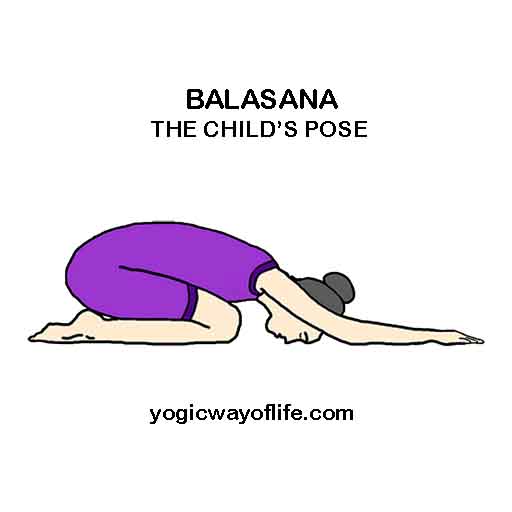Balasana or the Child’s Pose is an excellent resting pose. In Sanskrit, Bala means Child and Asana means a yoga pose. This asana or pose has been created by observing young children who naturally use this to relax. Balasana is one of the easiest relaxation poses and can be done by all practitioners. It can also be performed between asanas. It gives emotional and mental relaxation.
Avoid Balasana if you have any knee pain or severe lower back injury. Also those with high blood pressure should avoid this pose.

How to do Balasana (The Child’s Pose)
- Start with the kneeling position. Keep the feet and toes together.
- Now, spread your knees slightly apart. Inhale slowly and deeply.
- Slowly bend forward and let your chest rest between the thighs. Exhale as you are bending down. Let your hands be in front of you and resting on the floor, palms facing the mat.
- Adjust your pelvis and sacrum in such a way that your abdomen rests between the inner thighs and the back is stretched forward.
- The forehead should rest on the floor and palms facing downwards, fully touching the mat. The arms should be in line with the knees and fully stretched out and relaxed. If you have difficulty resting the forehead on the floor, you may use a pillow for support.
- Breathe normally in this position and feel the deep relaxation. Remain in this position for as long as you are comfortable.
- To release the pose, move your hands back and slowly raise yourself up to the kneeling position. To rest further, one can lie in the supine position (Shavasana) to relax the legs and lower back if required.
Benefits of Balasana (The Child’s Pose)
- Balasana is a good resting pose and removes fatigue.
- It relieves stress and anxiety and makes the mind peaceful.
- Balasana can be used for those who are in deep emotional stress. This asana releases emotional pain when done with deep and slow relaxed breathing.
- It releases stress in the shoulder and lower back. It gives a good stretch to the shoulder muscles, back muscles and the arms.
- It can be used by those suffering from neck pain as well as lower back pain. Those with lower back pain should follow it up with a counter backward bend pose like Makarasana or Bhujangasana.
- This pose stretches the spine and lengthens it.
There is a variation of Balasana, where the hands are kept on the side of the thighs, instead of stretching forward. In this position the hands are facing backwards and kept relaxed throughout.
